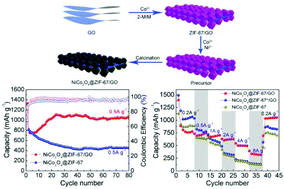Encapsulating NiCo2O4 inside metal–organic framework sandwiched graphene oxide 2D composite nanosheets for high-performance lithium-ion batteries†
Abstract
Ternary transition metal oxides are promising candidates for developing high-performance lithium-ion batteries. In the present investigation, we explored sandwiched composite nanosheets by encapsulating NiCo2O4 nanoparticles inside the pores of ZIF-67 crystals that were in situ grown on both surfaces of graphene oxide (GO). SEM and TEM observations confirmed the successful construction of the sophisticated architecture. For the designed electrode structure, the scaffold of GO provided a fast conductive highway for the encapsulated NiCo2O4 nanoparticles, while the porous and elastic framework of ZIF-67 together with the flexible GO guaranteed efficient accommodation to the volumetric change of NiCo2O4. Moreover, the highly porous composite nanosheets are suitable for electrolyte infiltration, with enhanced ionic transportation kinetics. Accordingly, the reversible capacity of NiCo2O4@ZIF-67/GO was high up to 1025 mA h g−1 and 740 mA h g−1 after 80 cycles at 0.5 and 2.0 A g−1, respectively. At the current density of 4.0 and 8.0 A g−1, the capacity was still retained at 500 and 320 mA h g−1, respectively. Other analyses further manifested that the distinctive structure of NiCo2O4@ZIF-67/GO enhanced the charge transportation kinetics in comparison with the control sample of NiCo2O4@ZIF-67. Our strategy provided a new concept for developing high-performance electrode materials of lithium-ion batteries.



 Please wait while we load your content...
Please wait while we load your content...